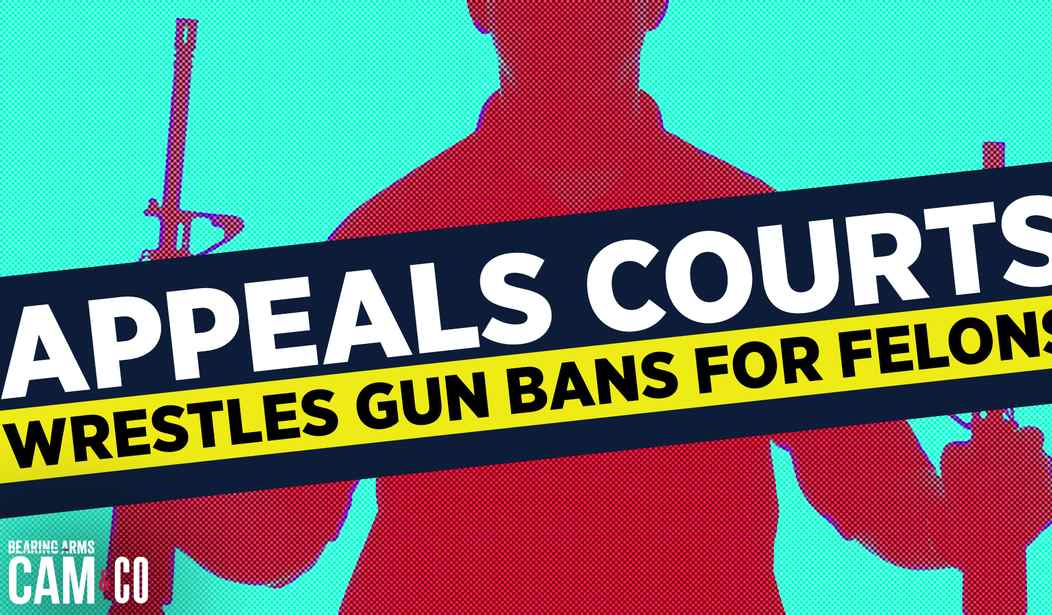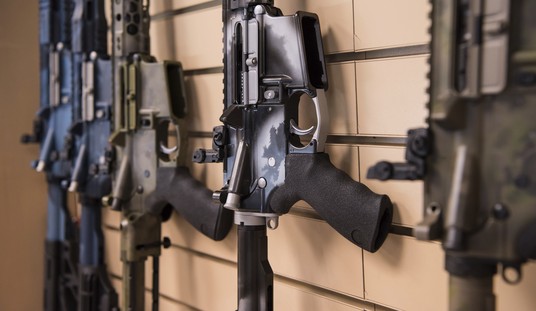News of the temporary restraining order granted against several of New Jersey’s new “sensitive places” broke just a few moments after I’d finished recording today’s Bearing Arms’ Cam & Co, but we’ll be talking about Judge Renée Marie Bumb’s decision on tomorrow’s show with Second Amendment Foundation founder and executive vice president Alan Gottlieb. Today, however, we’re delving into another Second Amendment issue percolating in the courts; the federal ban on firearm possession for all those convicted of a felony.
The Third Circuit Court of Appeals (interestingly, the same appellate court that will hear New Jersey’s appeal of Judge Bumb’s TRO) recently agreed to an en banc hearing of a case called Range v. Garland after a three-judge panel ruled that Range’s lifetime loss of his Second Amendment rights after a 1995 conviction for felony welfare fraud was not unconstitutional. While the fact that his case will now be taken up by the entirety of the Third Circuit doesn’t necessarily mean the decision will be overturned, it definitely indicates that there’s interest on the appellate court to dive deeper into the history of the right to keep and bear arms; particularly how today’s felon-in-possession law, established as part of the Gun Control Act of 1968, comports with the history and tradition of the Second Amendment at the time of the Founding and the ratification of the Fourteenth Amendment.
To that end, a new amicus brief just filed in the Fifth Circuit will hopefully be a part of the Third Circuit’s reading material, because it provides an excellent synopsis of why the current statute is problematic under the Bruen test. Filed by every federal public defender working within the Fifth District on behalf of a Texas man challenging the felon-in-possession law, the public defender’s brief argues that there is simply no historic tradition, or even an historic analogue comparable to todays’ sweeping prohibitions.
While the Third Circuit maintained in the Range case that the Second Amendment’s protections apply only to “law-abiding citizens,” the public defenders instead points to the fact that the text declares the right to be one “of the people”; a far broader category.
But neither Heller nor Bruen held that “the people” is limited to “law-abiding” citizens or excludes felons. Rather, Heller explained that “whatever else [the Second Amendment] leaves to future evaluation, it surely elevates above all other interests the right of law-abiding, responsible citizens to use arms in defense of heart and home.”
Similarly, in Bruen, the Court noted that it was undisputed that the petitioners, who were “two ordinary, law-abiding, adult citizens—are part of ‘the people.’”
The Court did not hold the reverse—that being law-abiding was a prerequisite to the basic protections of the Second Amendment. Such a reading would conflict with Bruen’s language that the “Second Amendment guaranteed to ‘all Americans’ the right to bear commonly used arms in public subject to certain reasonable, well-defined restrictions.”
Because the Second Amendment right belongs to “all Americans,” the categorical ban on an individual’s possession of a firearm based on their status as a felon is presumptively unconstitutional under the plain text of the Second Amendment. Whether a category of person can be disarmed is a question of historical tradition, which is the Government’s burden under Bruen.
It’s also an impossible task, according to the public defenders, who note that in the 17th and 18th century “categorical disarmament was largely reserved for Indians, indentured servants, slaves, black freedmen, and others outside the ‘body politic'”, a category that apparently didn’t include convicted felons. Instead, though there were proposals by ratifying conventions in New Hampshire, Pennsylvania, and Massachusetts to limit the right to keep and bear arms to “peaceable citizens” or to expressly allow for disarming individuals for “crimes committed,” neither drew enough support to be included in the text’s final wording.
A brief review of English and early American historical categorical firearms restrictions evidences a troubling tradition of disarming religious and political dissidents and targeted minority communities, but not felons. The Second Amendment is properly understood as a repudiation of many of these oppressive regulations, rather than an endorsement of such categorical restrictions. But, insofar as the United States incorporated any tradition of categorical exclusion, it assuredly did not include the targeted disarmament of felons until the 20th century.
We as a nation have not always fully recognized the inherent rights of we the people, but that doesn’t make our rights a wrong. Instead, its those misguided and oppressive policies that are in need of correction, and the public defenders maintain that applies to all those convicted of a felony in addition to those groups categorically denied their rights under the Second Amendment in the decades before the Gun Control Act of 1968.
I’m very curious to see what both the Third and Fifth Circuits decide in these respective cases. Will the current federal statute be enough of an historical analogue to pass muster? Will the en banc panel on the Third Circuit hold, as the three-judge panel did, that only “law-abiding” citizens possess the right to keep and bear arms? If so, does that open the door to banning gun possession for a host of non-violent, possessory misdemeanor offenses? And, most importantly, if either court concludes that a categorical ban on felons possessing firearms is unconstitutional, what will the Supreme Court do?
Justice Amy Coney Barrett has previously indicated while she was an appellate judge herself that the categorial ban on is unconstitutional, arguing instead that the standard should be dangerousness and not simply a felony conviction. History is consistent with common sense: it demonstrates that legislatures have the power to prohibit dangerous people from possessing guns. But that power extends only to people who are dangerous.
Founding-era legislatures did not strip felons of the right to bear arms simply because of their status as felons. Nor have the parties introduced any evidence that founding-era legislatures imposed virtue-based restrictions on the right; such restrictions applied to civic rights like voting and jury service, not to individual rights like the right to possess a gun. In 1791—and for well more than a century afterward—legislatures disqualified categories of people from the right to bear arms only when they judged that doing so was necessary to protect the public safety.
It remains to be seen if there are at least four other justices whose views fall in line with Barrett’s, but upholding the current statute isn’t a legal slam dunk for those wanting to keep the status quo in place. There’s a very strong case to be made that the current laws go too far in depriving every person convicted of a felony of one of their fundamental rights, and either the Third or Fifth circuits (better yet, both) could provide the lower-court split SCOTUS likes to see before it grants cert to decide a thorny legal question; in this case, should a felony conviction, even for a non-violent offense, deprive you forevermore of your fundamental right to keep and bear arms.









Join the conversation as a VIP Member